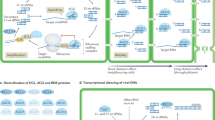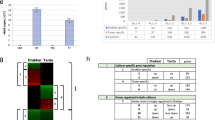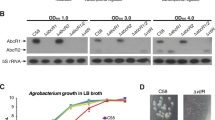Abstract
Regulation of gene expression through microRNAs (miRNAs) and antiviral defense through small interfering RNAs (siRNAs) are aspects of RNA silencing1, a process originally discovered as an unintended consequence of plant transformation by disarmed Agrobacterium tumefaciens strains2. Although RNA silencing protects cells against foreign genetic elements3, its defensive role against virulent, tumor-inducing bacteria has remained unexplored. Here, we show that siRNAs corresponding to transferred-DNA oncogenes initially accumulate in virulent A. tumefaciens–infected tissues and that RNA interference–deficient plants are hypersusceptible to the pathogen. Successful infection relies on a potent antisilencing state established in tumors whereby siRNA synthesis is specifically inhibited. This inhibition has only modest side effects on the miRNA pathway, shown here to be essential for disease development. The similarities and specificities of the A. tumefaciens RNA silencing interaction are discussed and contrasted with the situation encountered with plant viruses.
This is a preview of subscription content, access via your institution
Access options
Subscribe to this journal
Receive 12 print issues and online access
$209.00 per year
only $17.42 per issue
Buy this article
- Purchase on Springer Link
- Instant access to full article PDF
Prices may be subject to local taxes which are calculated during checkout





Similar content being viewed by others
References
Baulcombe, D. RNA silencing in plants. Nature 431, 356–363 (2004).
Napoli, C., Lemieux, C. & Jorgensen, R.A. Introduction of a chimeric chalcone synthase gene into Petunia results in reversible co-suppression of homologous genes in trans. Plant Cell 2, 279–289 (1990).
Voinnet, O. Induction and suppression of RNA silencing: insights from viral infections. Nat. Rev. Genet. 6, 206–220 (2005).
Tzfira, T., Li, J., Lacroix, B. & Citovsky, V. Agrobacterium T-DNA integration: molecules and models. Trends Genet. 20, 375–383 (2004).
Escobar, M.A. & Dandekar, A.M. Agrobacterium tumefaciens as an agent of disease. Trends Plant Sci. 8, 380–386 (2003).
Gelvin, S.B. Agricultural biotechnology: gene exchange by design. Nature 433, 583–584 (2005).
Bernstein, E., Caudy, A.A., Hammond, S.M. & Hannon, G.J. Role for a bidentate ribonuclease in the initiation step of RNA interference. Nature 409, 363–366 (2001).
Hammond, S.M., Bernstein, E., Beach, D. & Hannon, G. An RNA-directed nuclease mediates post-transcriptional gene silencing in Drosophila cell extracts. Nature 404, 293–296 (2000).
Ekwall, K. The RITS complex– a direct link between small RNA and heterochromatin. Mol. Cell 13, 304–305 (2004).
Xie, Z. et al. Genetic and functional diversification of small RNA pathways in plants. PLoS Biol. 2, E104 (2004).
Jacobsen, S.E., Running, M.P. & Meyerowitz, E.M. Disruption of an RNA helicase/RNAse III gene in Arabidopsis causes unregulated cell division in floral meristems. Development 126, 5231–5243 (1999).
Yu, B. et al. Methylation as a crucial step in plant microRNA biogenesis. Science 307, 932–935 (2005).
Bartel, B. & Bartel, D.P. MicroRNAs: at the root of plant development? Plant Physiol. 132, 709–717 (2003).
Gasciolli, V., Mallory, A.C., Bartel, D.P. & Vaucheret, H. Partially redundant functions of Arabidopsis DICER-like enzymes and a role for DCL4 in producing trans-acting siRNAs. Curr. Biol. 15, 1494–1500 (2005).
Allen, E., Xie, Z., Gustafson, A.M. & Carrington, J.C. MicroRNA-directed phasing during trans-acting siRNA biogenesis in plants. Cell 121, 207–221 (2005).
Dalmay, T., Hamilton, A.J., Rudd, S., Angell, S. & Baulcombe, D.C. An RNA-dependent RNA polymerase gene in Arabidopsis is required for posttranscriptional gene silencing mediated by a transgene but not by a virus. Cell 101, 543–553 (2000).
Chapman, E.J., Prokhnevsky, A.I., Gopinath, K., Dolja, V.V. & Carrington, J.C. Viral RNA silencing suppressors inhibit the microRNA pathway at an intermediate step. Genes Dev. 18, 1179–1186 (2004).
Dunoyer, P., Lecellier, C.H., Parizotto, E.A., Himber, C. & Voinnet, O. Probing the microRNA and small interfering RNA pathways with virus-encoded suppressors of RNA silencing. Plant Cell 16, 1235–1250 (2004).
Voinnet, O., Rivas, S., Mestre, P. & Baulcombe, D. An enhanced transient expression system in plants based on suppression of gene silencing by the p19 protein of tomato bushy stunt virus. Plant J. 33, 949–956 (2003).
Hamilton, A.J., Voinnet, O., Chappell, L. & Baulcombe, D.C. Two classes of short interfering RNA in RNA silencing. EMBO J. 21, 4671–4679 (2002).
Himber, C., Dunoyer, P., Moissiard, G., Ritzenthaler, C. & Voinnet, O. Transitivity-dependent and -independent cell-to-cell movement of RNA silencing. EMBO J. 22, 4523–4533 (2003).
Nam, J., Matthysse, A.G. & Gelvin, S.B. Differences in susceptibility of Arabidopsis ecotypes to crown gall disease may result from a deficiency in T-DNA integration. Plant Cell 9, 317–333 (1997).
Dalmay, T., Hamilton, A.J., Mueller, E. & Baulcombe, D.C. Potato virus X amplicons in arabidopsis mediate genetic and epigenetic gene silencing. Plant Cell 12, 369–379 (2000).
Parizotto, E.A., Dunoyer, P., Rahm, N., Himber, C. & Voinnet, O. In vivo investigation of the transcription, processing, endonucleolytic activity, and functional relevance of the spatial distribution of a plant miRNA. Genes Dev. 18, 2237–2242 (2004).
Cluster, P.D., O'Dell, M., Metzlaff, M. & Flavell, R.B. Details of T-DNA structural organization from a transgenic Petunia population exhibiting co-suppression. Plant Mol. Biol. 32, 1197–1203 (1996).
Gazzani, S., Lawerson, T., Woodward, D., Headon, R. & Sablowski, R. A link between mRNA turnover and RNA interference in Arabidopsis. Science 306, 1046–1048 (2004).
Ooms, G. et al. T-DNA organization in homogeneous and heterogeneous octopine-type crown gall tissues of Nicotiana tabacum. Cell 30, 589–597 (1982).
Chateau, S., Sangwan, R.S. & Sangwan-Norreel, B.S. Competence of Arabidopsis thaliana genotypes and mutants for Agrobacterium tumefaciens-mediated gene transfer: role of phytohormones. J. Exp. Bot. 51, 1961–1968 (2000).
Jones-Rhoades, M.W. & Bartel, D.P. Computational identification of plant microRNAs and their targets, including a stress-induced miRNA. Mol. Cell 14, 787–799 (2004).
Hood, E.E., Helmer, G.L., Fraley, R.T. & Chilton, M.D. The hypervirulence of Agrobacterium tumefaciens A281 is encoded in a region of pTiBo542 outside of T-DNA. J. Bacteriol. 168, 1291–1301 (1986).
Acknowledgements
We thank P. Zambryski and M. Matzke for critical reading of the manuscript, S. Gelvin for providing strains and the root inoculation protocol, members of the Voinnet lab for discussions and R. Wagner's team for plant care. This work was supported by an Action thématique et incitative sur programme Jeune Chercheur award from the Centre National de la Recherche Scientifique and a postdoctoral fellowship to P.D. from the Federation of European Biochemical Societies. O.V. is recipient of a Young Investigator Award from the European Molecular Biology Organization.
Author information
Authors and Affiliations
Corresponding author
Ethics declarations
Competing interests
The authors declare no competing financial interests.
Supplementary information
Supplementary Fig. 1
A. thaliana plants expressing the P19 and P1-HcPro viral silencing suppressors show decreased susceptibility to A. tumefaciens. (PDF 456 kb)
Supplementary Fig. 2
Absence of secondary siRNAs in stems and tumors from GF-RNAi plants with the rdr6 mutation. (PDF 331 kb)
Supplementary Fig. 3
Optimal virus accumulation in stems of DAN2 plants carrying the rdr6 mutation, compared with tumors developing on similar DAN2 tissues. (PDF 185 kb)
Supplementary Fig. 4
Specific transcriptional repression of miR393 in tumors. (PDF 239 kb)
Supplementary Table 1
A. tumefaciens susceptibility assays in roots of the dcl2-1, dcl3-1 and rdr2-1 mutants. (PDF 807 kb)
Rights and permissions
About this article
Cite this article
Dunoyer, P., Himber, C. & Voinnet, O. Induction, suppression and requirement of RNA silencing pathways in virulent Agrobacterium tumefaciens infections. Nat Genet 38, 258–263 (2006). https://doi.org/10.1038/ng1722
Received:
Accepted:
Published:
Issue Date:
DOI: https://doi.org/10.1038/ng1722
This article is cited by
-
P4 protein of an Indian isolate of rice tungro bacilliform virus modulates gene silencing
Virus Genes (2024)
-
Antisense RNA (asRNA) technology: the concept and applications in crop improvement and sustainable agriculture
Molecular Biology Reports (2023)
-
Agrobacterium-mediated gene transfer: recent advancements and layered immunity in plants
Planta (2022)
-
Biotic stress-induced epigenetic changes and transgenerational memory in plants
Biologia (2022)
-
Transgenic expression of Hyp-1 gene from Hypericum perforatum L. alters expression of defense-related genes and modulates recalcitrance to Agrobacterium tumefaciens
Planta (2020)



